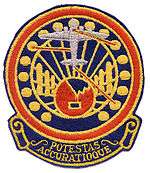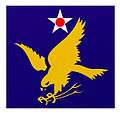379th Expeditionary Operations Group
| 379th Expeditionary Operations Group | |
|---|---|
|
Emblem of the 379th Expeditionary Operations Group | |
| Active | 1942–1945;2003–present |
| Country | |
| Branch | United States Air Force |


The 379th Expeditionary Operations Group (379 EOG) is a provisional United States Air Force unit assigned to the United States Air Forces Central. It is the flying component of the 379th Air Expeditionary Wing, stationed at Al Udeid AB, Qatar.
During World War II, its predecessor unit, the 379th Bombardment Group was a VIII Bomber Command B-17 Flying Fortress unit in England. Assigned to RAF Kimbolton in early 1943, the group flew more sorties than any other bomb group in the Eighth Air Force, and dropped a greater bomb tonnage than any other group. The combat record of the 379th was the most successful of all the Eighth Air Force heavy bomber groups, receiving two Distinguished Unit Citations.
The Group is the flying component of the 379th AEW, with more than 90 combat and support attached aircraft, including eight coalition airframes. Aircraft come from every US service, the United Kingdom, and Australia.
Assigned units
- 7th Expeditionary Airborne Command and Control Squadron
- 37th Expeditionary Bomb Squadron
- 71st Expeditionary Air Control Squadron
- 340th Expeditionary Air Refueling Squadron (KC-135)
- 379th Expeditionary Aeromedical Evacuation Squadron
- 379th Expeditionary Airlift Squadron
- 379th Expeditionary Operations Support Squadron
- 746th Expeditionary Airlift Squadron
- 763d Expeditionary Reconnaissance Squadron (RC-135)
History
- For additional history and lineage, see 379th Air Expeditionary Wing
World War II




The group was activated on 26 November 1942 at Gowen Field, Idaho. It assembled at Wendover Field, Utah on 2 December 1942. They trained there until 2 March 1943. Then moved to Sioux City AAB Iowa on 3 February 1943 until their departure on 9 April 1943. The ground echelon moved for final processing at Camp Douglas, Wis, and then to Camp Shanks, New York. They sailed on the SS Aquitania on 10 May 1943, and arrived at Clyde on 18 May 1943. The aircraft left Sioux City on 9 April 1943 for Bangor, Maine, via Kearney, Nebraska, and Selfridge, Michigan. They commenced overseas movement on 15 April 1943 by the North Atlantic ferry route from Presque Isle, Maine via Greenland, Iceland to Prestwick, Scotland.
Arrived in England in May 1943, assigned to VIII Bomber Command, 41st Combat Bombardment Wing. Stationed at RAF Kimbolton, assigned Triangle-K as its tail identification code.
The 379th BG began operations with Eighth AF on 19 May 1943, and received a Distinguished Unit Citation for operations over Europe from May 1943 through July 1944. The group engaged primarily in bombardment of strategic targets such as industries, oil refineries, storage plants, submarine pens, airfields and communications centres in Germany, France, the Netherlands, Belgium, Norway and Poland.
Specific targets included a chemical plant in Ludwigshafen, an aircraft assembly plant in Brunswick, ball-bearing plants at Schweinfurt and Leipzig, synthetic oil refineries at Merseburg and Gelsenkirchen, marshalling yards at Hamm and Reims and airfields in Mesnil au Val and Berlin.
The Group received another DUC for flying without fighter protection into central Germany to attack vital aircraft factories on 11 January 1944. On several occasions the Group attacked interdictory targets and operated in support of ground forces. It bombed V-weapon sites, airfields, radar stations and other installations before the Normandy invasion in June 1944, bombed defended positions just ahead of the Allied landings on 6 June and struck airfields, rail choke points, and gun emplacements during the campaign that followed.
During the Battle of France, the Group bombed enemy positions to assist ground troops at St Lo during the breakthrough, 24–25 July 1944, attacked German communications and fortifications during the Battle of the Bulge, December 1944 – January 1945, and bombed bridges and viaducts in France and Germany to aid the Allied assault across the Rhine, February–March 1945.
The combat record of the 379th was the most successful of all the Eighth Air Force heavy bomber groups. It held records as far as bomb tonnage dropped – 26,459 tons – more than any other unit including those operational before the 379th arrived in the UK. It also exceeded all other UK Bomb Groups in the total number of missions flown, carrying out 330 between May 1943 and 15 May 1945. One B-17G, "Ol Gappy", itself completed 157 missions, probably more than any other Eighth Air Force bomber.
Scheduled to transport US troops from Europe to Casablanca. The unit moved to Casablanca in early June with the last aircraft flown back to the States and the Group inactivated as Casablanca on the 25 July 1945.
Cold War
On 1 April 1960, jurisdiction of Wurtsmith was transferred from Air Defense Command to Strategic Air Command. The 379th Bombardment Wing became the Base Host Operating unit, being moved from Homestead AFB, Florida. The 379th and its subordinate units' mission was to operate at full readiness, and support activities included aircraft and vehicle maintenance, bombing crew and unit training, and air refueling support. The wing did not deploy bomber aircraft to Southeast Asia during the Vietnam War, as the B-52H was dedicated to strategic deterrence. In 1977, the 379th exchanged their B-52Hs for the conventional bomb capable B-52G. Wurtsmith AFB closed on 30 June 1993 as a result of the 1991 Base Realignment and Closure (BRAC) process, which determined that the development of new weapons and long-range satellite surveillance systems rendered many installations unnecessary. On the morning of 15 December 1992, the last B-52G, AF Serial No. 57-6492, the "Old CrowExpress," was flown to Davis-Monthan Air Force Base for storage.
The group was re-activated in 2003 as the 379th Expeditionary Operations Group. Engaged in combat operations as part of Global War on Terrorism.
Lineage
- Constituted as 379th Bombardment Group (Heavy) on 28 October 1942
- Activated on 3 November 1942
- Inactivated on 25 July 1945
- Redesignated 379th Expeditionary Operations Group and converted to provisional status 2003 (date TBD)
- Activated in 2003 (Date TBD)
Assignments
- II Bomber Command, 3 November 1942 – April 1943
- 1st Bombardment Wing, May 1943 – 13 September 1943
- Attached to: 201st Provisional Combat Bombardment Wing, May – 13 September 1943
- 41st Combat Bombardment Wing, 13 September 1943
- European Air Materiel Command, 12 – 25 July 1945
- 379th Air Expeditionary Wing, 2003 – present
Components
- 524th Bombardment Squadron (WA), 3 November 1942 – 25 July 1945
- 525th Bombardment Squadron (FR), 3 November 1942 – 25 July 1945
- 526th Bombardment Squadron (LF), 3 November 1942 – 25 July 1945
- 527th Bombardment Squadron (FO), 3 November 1942 – 25 July 1945
Stations
- Geiger Field, Washington, 3 November 1942
- Wendover Field, Utah, 19 November 1942
- Sioux City Army Air Base, Iowa, 3 February – April 1943
- RAF Kimbolton (USAAF Station 117), England, 21 May 1943 – 12 June 1945
- Air echelon at RAF Bovingdon (USAAF Station 112), 24 April 1943 – 21 May 1943
- Casablanca Airfield, French Morocco, 17 June – 25 July 1945
- Al Udeid AB, Southwest Asia, 2003 – present
Aircraft assigned
- B-17 Flying Fortress, 1942 – 1945
- Undisclosed, 2003 – present
- RC-135 Rivet Joint - present
- E-8 JSTARS - present
- KC-135 Stratotanker - present
- C-130 Hercules - present
- C-21 - present
- B-1B Lancer - present
References
![]() This article incorporates public domain material from the Air Force Historical Research Agency website http://www.afhra.af.mil/.
This article incorporates public domain material from the Air Force Historical Research Agency website http://www.afhra.af.mil/.
- Freeman, Roger A. (1978) Airfields of the Eighth: Then and Now. After the Battle ISBN 0-900913-09-6
- Freeman, Roger A. (1991) The Mighty Eighth The Colour Record. Cassell & Co. ISBN 0-304-35708-1
- Maurer, Maurer (1983). Air Force Combat Units Of World War II. Maxwell AFB, Alabama: Office of Air Force History. ISBN 0-89201-092-4.
External links
| Wikimedia Commons has media related to 379th Expeditionary Operations Group. |
- Bendiner, Elmer. The Fall of the Fortress. A Personal Account of the Most Daring -and Deadly- American Air Battles of World War II. New York: G.P. Putnam's Sons, 1980.
- Cassens, Kenneth H. Screwball Express: A Meaningful Tribute to the 8th Air Force, 379th Bomb Group & the Screwball Express. Paducah, Kentucky: Turner Publications, 1992.
- Robb, Derwyn D. Shades of Kimbolton, a Narrative of the 379th Bombardment Group (H). San Angelo, Texas: Newsfoto Publishing Company, 1946 (2nd edition 1981).
- 379th Bombardment Group Association

